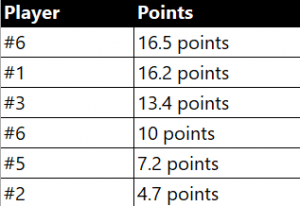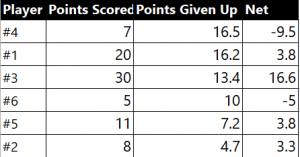In Charting Defensive Accountability: Part I earlier we promised further thoughts on charting defensive accountability. If you open the Sample Game file we can begin:
- The team in question gave up 68 points in this specific game and to the far right are listed the defensive categories those points fell under. In that particular game, 25 points were directly attributed to unsatisfactory closeouts and another significant total of 14 points given up were the direct cause of faulty containment on the ball. So, exactly half of the 68 points given up were attributed to just two areas-containment and closure. It sounds almost too simple but the chart directs us to where we need to go to “fix” our issues. This method points out trends as they happen and can help us focus and fix.
- *Keep in mind that in other games, this particular team has had issues surrendering points on post-ups and screen/rolls. The defensive accountability is going to reflect opponents’ personnel and X and O strengths. No matter, fixing issues as they happen will pay dividends down the road when similar personnel and X and O issues arise again.
- For purposes of this article, we’ll concentrate on just the six players who “gave up” points. If you wanted to concentrate on defense alone the “By Player” accountability reads:
- Listing it this way, we can focus on just an individual’s defensive performance in that particular game. Then there’s the cumulative season “Points Given Up” which gives us a much broader view of how a player and team fare over a large number of games. Of course, individual matchup assignments can affect these numbers significantly. If Player #6, who gave up 16.5 points, consistently gets the opponent’s toughest matchup, that obviously needs to be taken into consideration.
- Another way to analyze “Points Given Up” is to compare those individual game numbers to the Points Scored for each individual. In the sample game, it looks like this:
- As we mentioned in Part l of this discussion, I’d much rather go into this detail to analyze my players’ defensive performances than to have a mathematical equation or a service tagger chart my defense when the formula or the tagger doesn’t understand my defense.
- This method also allows for changing the nature of a defensive assignment from game to game or even in game. For instance, if I’m hedging on screen/rolls on Monday, but switching in Saturday’s game, I know that and can chart accordingly.
- Also, as mentioned previously, the NBA (+/-) stat has its value but it too has its flaws that we don’t need to discuss again but if you or I were on the court with Curry, Durant, Green and Thompson, our (+/-) number would look pretty good. PER and EFF also have great value for analyzing individual performance but they are primarily offense-oriented.
In our next article, we’ll discuss yet another aspect of defensive accountability and how it might help us zero in problems we might be having.




